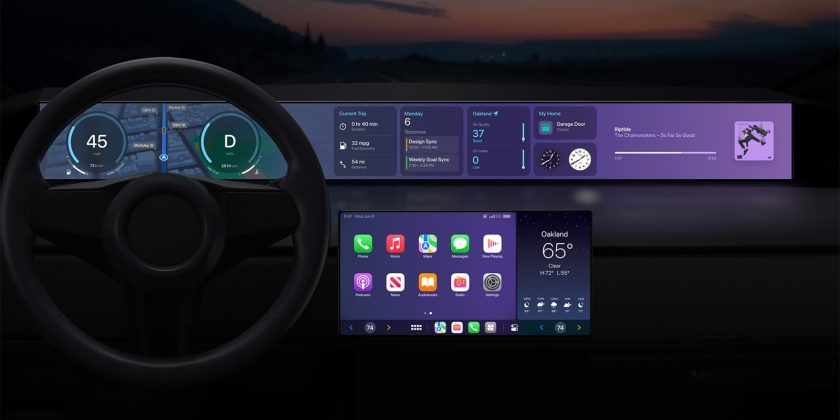The next generation of Apple CarPlay, the tech giant’s in-car phone integration software, was unveiled at today’s big company keynote event. Apple showed off a new interface that can more completely integrate CarPlay with vehicle systems and screens, including both the dashboard and driver displays. It likely previews a version of something we expect to show up on Apple’s own vehicle platform, in whatever form that eventually takes, which has long been rumored to be in development.
Apple has been reportedly working on a more-integrated car system, and potentially even building its own car from scratch, for nearly a decade now, with little more than Apple CarPlay to show for it so far. However, the latest rumors suggest the company is still developing its own autonomous vehicle system with a focus on a bespoke user experience developed in-house, which will likely expand upon the look and features of CarPlay’s humble beginnings. Today, with the announcement of next-gen CarPlay software, we have a better idea of where the software side of Apple’s car venture could be headed.
Announced today, the latest generation of Apple CarPlay will deeply integrate with vehicle hardware in unprecedented ways, now with adaptive software and menus that can function behind multiple screens in the vehicle interior, not just the main dashboard interface, like before. Apple claims the new integration will allow users to override traditional vehicle information, including driver display elements like speed, fuel level, temperature, and other instrument cluster details in a new personalized display that taps into the vehicle’s data systems for accurate readouts. Apple says this better-integrated CarPlay will offer a “unified and consistent” user experience.
The new generation lets users choose different gauge cluster designs in a new layout of application widgets, which could include weather and music readouts alongside the vital vehicle information. The company also announced updates to its Maps application, now letting users plan up to 15 stops along a route, which automatically sync from Mac to iPhone when planning. Apple kept its CarPlay presentation short, promising to share a list of compatible vehicles next year and more detailed information on the new setup in the near future.
In images provided by Apple of the next-gen CarPlay at work, we can see it natively adapting to accommodate the driver and passenger screens, as well as any additional screen real estate potentially available on the interior. The main dashboard screen layout has been updated and reflects Tesla’s own layout with a lower-edge application and information bar, with new buttons that show how the updated system can now take over climate control functionality.
Above that, the example vehicle’s giant secondary dashboard screen utilizes Apple’s widget system to show trip information, navigation instructions, home functions like opening the garage door, a calendar, a traditional clock, and of course a readout of what’s playing on the vehicle’s audio system. We expect something familiar to this layout to show up on Apple’s own car project, as well.
All we’ve had to go on up until today’s Apple keynote mostly comes from patents and trademarks, and rumors about what the tech giant is working on. Apple has been researching methods of reducing motion sickness from virtual reality goggles for an automotive application, and we can even expect an Apple car to have a sunroof, all thanks to patent applications. Now we have a better idea of what Apple’s future “unified” user interface system probably looks like, and can’t wait to give it a try.
Hot Reads
As Some 2021 Ford Bronco V-6 Engines Fail, NHTSA Gets Involved
2022 Mazda CX-5 Turbo First Test: Not Trying to Be Everything to Everybody
Ford Trolls Tesla With F-150 Lightning Accessory (Even if CEO Says It’s Not Trolling)
How New Apple CarPlay Will Revolutionize Your Car’s Dashboard
Next-Gen Toyota Tacoma and 4Runner Likely Borrowing Tundra’s Platform
Source: Read Full Article
